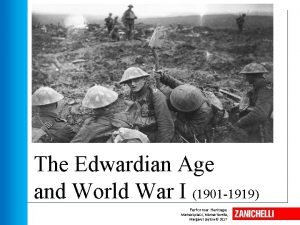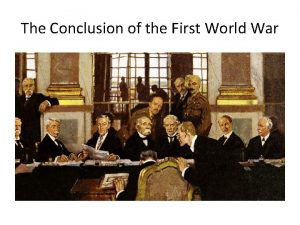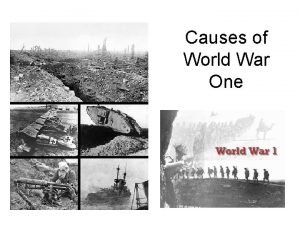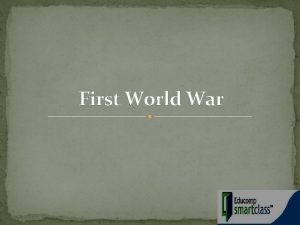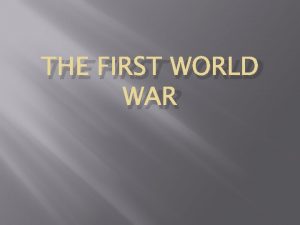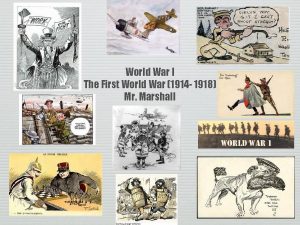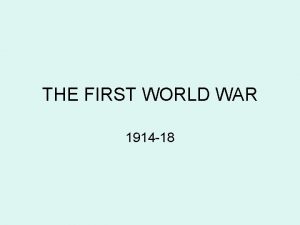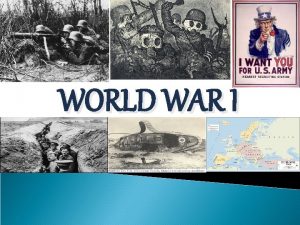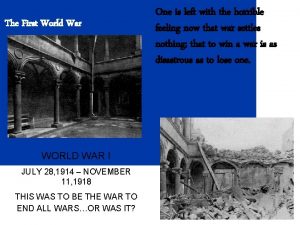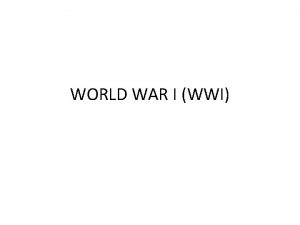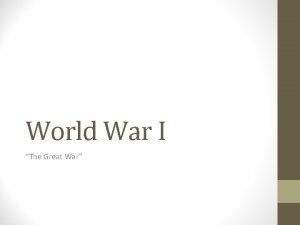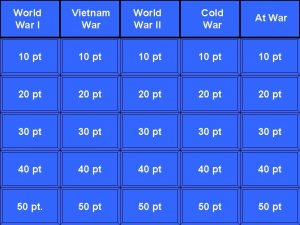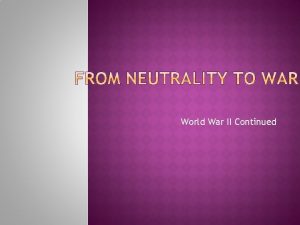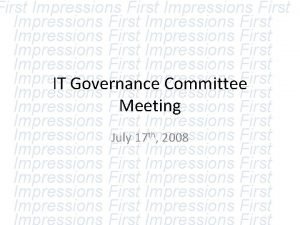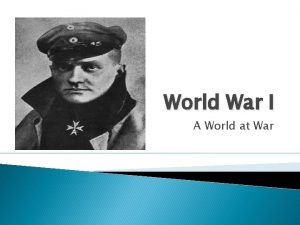World War I The First World War was








































- Slides: 40

World War I The First World War was known as “The Great War” in it’s day and was to be “the war to end all wars. ” : //www. youtube. com/wat ch? v=m. ML 4 xir. KTu 8 http: //www. youtube. com/watch? v=Iea. Lbo 6 hew 8&safe=active

4 Long Term Causes of WWI MAIN Militarism - the build up of weapons to protect a country in the event of war The Alliance System - countries in Europe began to ally with others that had common interest

Pre-WWI Alliances

The Alliances of WWI THE CENTRAL POWERS - Germany, Austria-Hungary, and Italy* (Italy changes sides in 1915 and is not a major player after this) THE ALLIED POWERS - Great Britain, France, and Russia (The U. S. Remains neutral in 1914)

Imperialism - the practice of extending a nation’s power by gaining territories for a colonial empire. Nationalism - each country in Europe thought their country was the best. Result of Long Term Causes TENSION in Europe, a small area that has many different countries and points of view by 1914!

Short Term Causes of WWI 1. Serbian Nationalism - The Serbs in Austria-Hungary wanted to form a unified South Slav state. *Gavrilo Princip (seen in photo) was a member in a nationalist group, THE BLACK HAND. He single handedly would change the course of history!

2. The Assassination of Archduke Francis Ferdinand by a Serb Bosnian was the fuse to light the “powderkeg” of tension in Europe. 3. Mobilization - Soon, the ALLIANCE SYSTEMS that had been established prior to this began to act.

WWI Primary Source Document ASSASINATION OF THE AUSTRIAN ROYAL HEIR AND WIFE Shot by student in Bosnian capital Monday June 29, 1914 The Archduke Francis Ferdinand of Austria, nephew of the aged Emperor and heir to the throne, was assassinated in the streets of Sarayevo, the Bosnian capital, yesterday afternoon. His wife, the Duchess of Hohenberg, was killed by the same assassin. Some reports say the Duchess was deliberately shielding her husband from the second shot when she was killed. One victim was struck in the body and the other in the face; the telegrams are contradictory about which wound the Archduke suffered and which his wife. Two attempts were made on the Archduke's life during the day. He was in Bosnia inspecting the manoeuvres of the Austrian Army Corps stationed in the province, and had devoted yesterday to a procession through the capital. During the morning a bomb was thrown at the Imperial motor-car, but its occupants escaped unhurt. In the afternoon in another part of the town a Serb student fired a revolver at the car, killing both the Archduke and the Duchess. . Manchester Guardian, 29/06/14

Steps to War in 1914 June 28 th - Archduke Francis Ferdinand Assassinated July 28 th (1 month later) - Austria. Hungary Declares War on Serbia July 30 th (2 days later) - Russia (Serbia’s Ally) begins to MOBILIZE armed forces August 1 st (2 days later) - Germany (Austria-Hungary’s Ally) declares war on Russia

August 3 rd (2 days later) - Germany declares war on France (Russia’s ally), and begins the invasion of Belgium August 4 th (1 day later) - Britain (who had pledged to protect Belgium) declared war on Germany August 6 th (2 days later) - Austria. Hungary declares war on Russia August 12 th (6 days later) - France and Britain declare war on Austria-Hungary

And all this Happened in: 15 Days!

Maps of WWI Fighting Upper Left: The Western Front Upper Right: The Eastern Front Bottom: The Alliance System

Major Battle Fronts (1914 -1917) The First Battle of the Marne (Sept. 1914) - As the Germans are approaching France, the French launch a daring counterattack against the Germans and they retreat. The Battle for Verdun (Dec. 1915) - Longest battle in the war (10 months) and one of the deadliest. France was still able to hold off Germany. The War in the Atlantic - Fighting in the North Sea and the Atlantic Ocean between the navies of Britain and Germany involved the blockading of ports and the placing of explosive mines on the ocean floor. German U-boats were causing heavy British losses.

Trench Warfare in World War I

War of Attrition- a slow wearing down process in which each side tires to outlast the other.

New Technology Machine Guns Poison Gas (chlorine and mustard gas) Tanks Airplanes


New Rules to War It now seemed that all RULES OF WAR were gone Civilians were now needed to fight and die This was the first modern war This was the first Total War

American Neutrality (1914 -17) At first, many Americans believed the Great War to be a European war American merchants, however, traded with the warring European nations. While the U. S. tried to support both sides financially, her ships carried most of its supplies to the Allied Powers and most identified with the Allies. America was a country made of immigrants, so some families had personal interest in one side or the other

America Moves to War The Sinking of the Lusitania - In May of 1915, a German U-boat sank the British passenger liner and killed 128 Americans

Unrestricted German Submarine Warfare - angered many Americans because Germany was not respecting our claims of neutrality

Sussex Pledge • One year later, Germany sinks a French passenger ship, The Sussex. The world is outraged that they would attack civilians • Germany makes the Sussex Pledge promising not to do this and to stop unrestricted Submarine Warfare. • They don’t intend to keep the promise.

The Zimmerman Note Germany pledged to help Mexico regain Texas, New Mexico, and Arizona if they joined the Central Powers; angered Americans; Congress declares war April 6 th, 1917. Coded Message

De-Coded Message

Russian Revolution - Meanwhile there was trouble in Russia in 1917, Russian Czar Nicholas II is overthrown; Russia withdraws from the war in Nov. 1917 and American presence is needed even more.

America Mobilizes for War SOLDIERS - The draft is enacted by the SELECTIVE SERVICE ACT of 1917; 3 million WWI American draftees; they were named the AMERICAN EXPEDITIONARY FORCE (AEF) PROPAGANDA - The COMMITTEE ON PUBLIC INFORMATION (CPI) is created to rally support for the war effort. They take advantage of the Lusitania, Sussex, and Zimmerman note ECONOMIC SUPPORT - The government increased income taxes and issued war bonds (aka liberty bonds) WOMEN - play a major role as volunteers in France and workers in U. S. industry (they are nurses, signalers, typists, interpreters, drivers, Red Cross volunteers, factory workers, etc. )

Soldiers 339 th infantry leaves for Russia Shore detail from the U. S. S Olympia

Propaganda

Economic Support

Anna Gove in the olive drab uniform with members of the American Red Cross staff in France. This photo shows the many variations of the nurse's uniform. American Red Cross Bureau of Photography photograph Women

Restrictions on Freedom in the U. S. PACIFISTS - The Espionage Act of 1917 and the Sedition Act of 1918 penalized Americans who acted out against the war effort. GERMAN AMERICANS - faced hard times in America; German things were often renamed. AFRICAN AMERICANS - While there were some African American in segregated combat units, most African Americans filled noncombat roles.

American’s “OVER THERE” AEF - Lead by General John J. Pershing; they spend about 3 months training German Offensive - After Russia drops out and before U. S. troops are fully trained, Germany tries to break the trench stalemate on the western front Major Battles involving U. S. troops in France Cantigny, Chateau-Thierry, Belleau Wod, the Second Battle of the Marne, Meuse-Argonne (Argonne Forest)

John J. Pershing One of America's most famous Army officers, Pershing was born in Missouri on September 13, 1860. He graduated from West Point in 1886 and served in the Spanish-American War, the Philippines Insurrection, the Mexican Expedition and was the overall American Commander in Europe during World War I.

The War Ends January 8 th, 1918 - Wilson’s 14 points for peace speech November 11 th, 1918 - Fighting ends at the “ 11 th hour of the 11 th day of the 11 th month” with an Armistice January 1919 - Paris Peace Conference meeting between the Big Four who dominated the conference - Pres. Woodrow Wilson (U. S. ), Prime Minister David Lloyd George (Great Britain), Premier Georges Clemenceau (France), and Prime Minister Vittorio Orlando (Italy) June 28, 1919 - The Treaty of Versailles is signed; the U. S. does not agree with the treaty and signs a treaty during the Harding administration with Germany.

The Big Four (left to right: George, Orlando, Clemenceau, Wilson)

Wilson v. The European Powers Wilson’s Objectives of the European 1. “Peace without victory” Powers 2. World Peace 1. Hold Germany accountable 3. End of Secret Alliances for war 4. Freedom of the Seas 2. Establish buffer zones 5. Free Trade between France and Germany 6. Weapons Reduction 3. Protect the national interests 7. Impartial Handling of Borderof the Allied Powers disputes 4. Extend Power of Allied 8. Self-determination Nations 9. League of Nations 5. Gain wealth

Cost of the Great War • The Allies lost more than 5 million soldiers on the battle field. • 112, 000 U. S. soldiers died (more than half from sickness). • The Central Powers lost about 3. 5 million soldiers. • More than 20 million soldiers on BOTH sides were injured. • Russia suffered the most casualties of any country involved. • The total cost of the war was an estimated $330 billion.

Global Map of WWI


Map of Europe in 1919
 Why was the civil war the first modern war
Why was the civil war the first modern war The edwardian age and world war i zanichelli
The edwardian age and world war i zanichelli Conclusion of world war 1
Conclusion of world war 1 Triple alliance
Triple alliance Hát kết hợp bộ gõ cơ thể
Hát kết hợp bộ gõ cơ thể Slidetodoc
Slidetodoc Bổ thể
Bổ thể Tỉ lệ cơ thể trẻ em
Tỉ lệ cơ thể trẻ em Chó sói
Chó sói Tư thế worm breton là gì
Tư thế worm breton là gì Bài hát chúa yêu trần thế alleluia
Bài hát chúa yêu trần thế alleluia Các môn thể thao bắt đầu bằng tiếng chạy
Các môn thể thao bắt đầu bằng tiếng chạy Thế nào là hệ số cao nhất
Thế nào là hệ số cao nhất Các châu lục và đại dương trên thế giới
Các châu lục và đại dương trên thế giới Công thức tính độ biến thiên đông lượng
Công thức tính độ biến thiên đông lượng Trời xanh đây là của chúng ta thể thơ
Trời xanh đây là của chúng ta thể thơ Mật thư anh em như thể tay chân
Mật thư anh em như thể tay chân 101012 bằng
101012 bằng độ dài liên kết
độ dài liên kết Các châu lục và đại dương trên thế giới
Các châu lục và đại dương trên thế giới Thơ thất ngôn tứ tuyệt đường luật
Thơ thất ngôn tứ tuyệt đường luật Quá trình desamine hóa có thể tạo ra
Quá trình desamine hóa có thể tạo ra Một số thể thơ truyền thống
Một số thể thơ truyền thống Cái miệng xinh xinh thế chỉ nói điều hay thôi
Cái miệng xinh xinh thế chỉ nói điều hay thôi Vẽ hình chiếu vuông góc của vật thể sau
Vẽ hình chiếu vuông góc của vật thể sau Biện pháp chống mỏi cơ
Biện pháp chống mỏi cơ đặc điểm cơ thể của người tối cổ
đặc điểm cơ thể của người tối cổ Thế nào là giọng cùng tên? *
Thế nào là giọng cùng tên? * Vẽ hình chiếu đứng bằng cạnh của vật thể
Vẽ hình chiếu đứng bằng cạnh của vật thể Phối cảnh
Phối cảnh Thẻ vin
Thẻ vin đại từ thay thế
đại từ thay thế điện thế nghỉ
điện thế nghỉ Tư thế ngồi viết
Tư thế ngồi viết Diễn thế sinh thái là
Diễn thế sinh thái là Dạng đột biến một nhiễm là
Dạng đột biến một nhiễm là Thế nào là số nguyên tố
Thế nào là số nguyên tố Tư thế ngồi viết
Tư thế ngồi viết Lời thề hippocrates
Lời thề hippocrates Thiếu nhi thế giới liên hoan
Thiếu nhi thế giới liên hoan ưu thế lai là gì
ưu thế lai là gì

